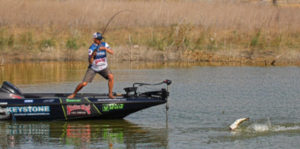The Right Fishing Line for Soft Plastics

Using the right fishing line will help you land fish
Your line is the crucial connection when using Carolina and Texas rigs
By David A. Rose
from The Fishing Wire
Every few years, one of the best bass-tournament pros in the nation sweeps the competition during a major derby, landing the largest limit of fish while rigging their favorite soft plastics in an innovative way. After that, what was once their secret technique suddenly becomes all the rage. The drop-shot rig, Neko rig and advances in wacky-rigging are just a few techniques that have come to the forefront during the past couple of decades after major tournament successes.
But when all is said and done, even after these fresh approaches have become widespread, two rigs still stand the test of time – both sticking out as must-use-when-all-else-is-failing techniques: the Carolina rig and the Texas rig.
Worms? Lizards? Tubes? Creature baits? It really doesn’t matter what your go-to bait is, as both Carolina and Texas rigs have been catching fish almost since soft plastics were first created.
But like any well-established technique (and I mean any,) the single most important connection between you and any fish is your line.
The Missing Link
Seaguar Pro Chris Zaldain is a 33-year-old Bassmaster Elite tournament angler from Laughlin, Nevada, who has taken top honors twice in Bassmaster Elite events, as well numerous top 20 finishes. This carries his winnings over the half-million-dollar mark since his start only 8 years ago.
“There’s no doubt, line is the most crucial link when using both Carolina and Texas rigs,” says the Seaguar pro. “I have been using Seaguar fluorocarbon since the early 2000’s, well before I wore their logo on my jersey [2010], and I’m here to tell you, I have literally spooled many, many miles of it on my reels since I started fishing.
“Seaguar fishing lines have helped me fool fish in the clear-water lakes I fished growing up, and it was InvizX that was my choice from the very day I started. And InvizX is still is a line I trust today because it’s super soft and allows me to cast any lure with ease. And I’ve never had a knot I’ve tied with it unravel.”
Everything’s Bigger When Texas-Rigging…Maybe
One of the most weedless/snagless methods of delivering a lure to a lunker is the Texas rig. Zaldain uses 1/4- to 3/8-ounce weights, pegging them to his hook and soft plastic with a bobber stop on 15-pound-test InvizX.
“That particular pound-test isn’t too light for most applications and hook-sets; yet, it’s not so heavy that it hinders the action of your bait,” Zaldain states. “And 15-pound test Seaguar InvizX is as strong as other manufacture’s 20-pound test, but with a smaller overall line diameter. And the thinner a line is, the more bites you’ll get.
“It boils down to the fact that the thinner the line, the more naturally a bait moves in the water. It just moves more like the real thing…period.”
Zaldain is never nervous about using InvizX for his Texas-rigged offerings for near-shore shallow-water fish, even amongst submerged trees or along steep, rocky bluffs; the line’s suppleness allows it to snake through limbs and around shale with ease. Moreover, it has plenty of abrasion resistance to pull even the heftiest largemouth from structure without worrying about getting nicked up and breaking off.
Also, InvizX fluorocarbon has less stretch than monofilament, which allows Zaldain to feel a strike the moment it occurs. This means he’s able to set the hook and pull a fish out of its snag-infested haunt before it even knows it being bit back.
Cover Me, I’m Going in… Carolina-Style
Along thick-and-gnarly structure in deep water is where Zaldain tends to employ the Carolina rig—which was devised to separate the weight from your offering so that the latter has a natural, horizontal free-swimming movement verses the more precise bottom-bouncing motion of a Texas-rigged bait.
“My line of choice with long-leader Carolina rig applications is Seaguar AbrazX because of its extreme abrasion resistance,” Zaldain states.
If structure isn’t extremely dense, Zaldain still uses 15-pound-test – rarely anything lighter. When the bass are utilizing extremely-thick cover, conversely, he will boost his leader to 20-pound test.
Complementing the lower stretch and sensitivity of fluorocarbon, Zaldain prefers what he calls “old-school” lead bullet-style weights over tungsten. With the former, he claims, he can feel what’s on bottom much better.
Telegraphed through the lead weight, line and then rod, he can sense the difference between gravel verses rock, for example, which lets him know when to lift his Carolina-rigged offering up and out of a snag. Zaldain starts with a 3/4-ounce bullet or egg-sinker weight above his bead and swivel, and then adjusts his rig from there.
Lessons Learned
Without a doubt, your line is the only link between you and any fish, whether you’re using the newest technique to hit the tournament trail or the most tried and true rigs ever created, like Texas and Carolina rigs.
Overall, use the lightest line you can get away with, but have different rods spooled with diverse pound test and toughness (abrasion resistance); because where you find fish may change with every cast.